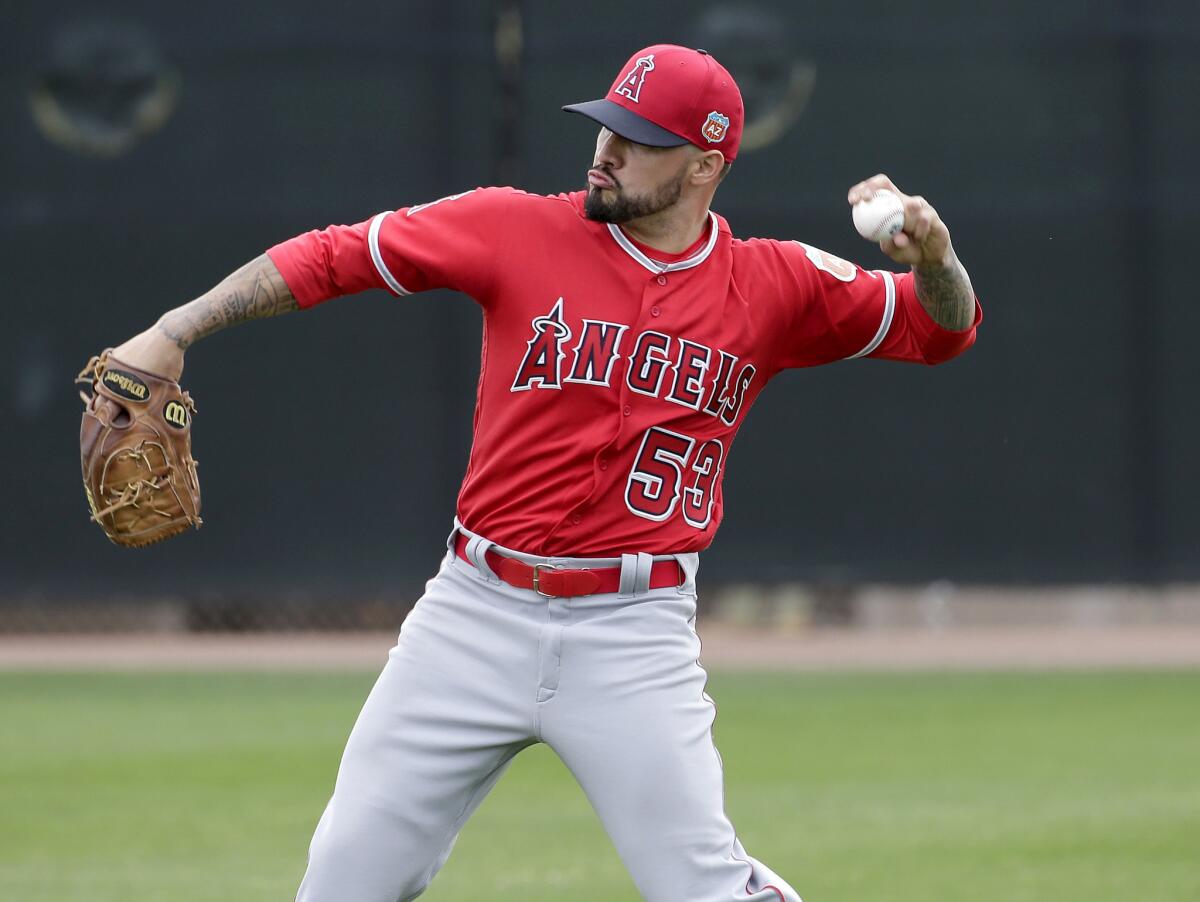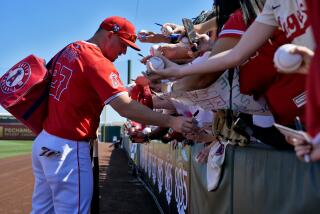Angels’ Hector Santiago is making changes as he competes to be in rotation

Angels starting pitcher Hector Santiago throws during spring training workouts in Tempe, Ariz.
Reporting from Tempe, Ariz. — In the final of Angels left-hander Hector Santiago’s five at-bats last season, he gleaned a tip that has informed the way he is now approaching his pitching.
He was facing Zack Greinke, then a dominant Dodgers right-hander, and he was ready for a fastball in a 2-2 count. The pitch came in hot, and so Santiago prepared to swing at a fastball. At the last moment, the pitch darted down, and Santiago looked foolish while striking out.
“What the hell?” Santiago asked himself. “What was that?”
It was Greinke’s changeup, coming in at 89 mph. The previous pitch, a fastball, had been clocked at 92. Greinke, now an Arizona Diamondback, found unprecedented success last season by adjusting the paradigm on which pitchers change velocity to confuse hitters.
Typically, the wider a pitcher’s possible range, the better. A 95-mph fastball mixed with a 75-mph curve was considered great. In some cases, it still is.
But in 2015, Greinke attempted to throw as many of his pitches as possible within a thin margin. He threw his four-seam fastball at 92, his two-seamer at 91, his changeup at 88 and his slider at 87. The speed with which his pitches approached the plate no longer tipped off hitters as to what was coming, and he led Major League Baseball with his 1.66 earned-run average.
Last season, Santiago threw his fastball at 90, his slider at 79 and his other pitches at all sorts of speeds. He wants to bring those two numbers closer together to confuse the hitters he’ll face like Greinke confused him.
A model on his own team is right-hander Garrett Richards, who peaked his slider above 90 mph on select occasions while averaging 96 with his fastball.

Times reporter Pedro Moura discusses Mike Trout’s arrival at the Angels’ spring training camp.
“Obviously I’m not gonna do that,” Santiago said, “but that differential is what you want.”
Santiago, 28, spent the off-season thinking he was going to be traded.
“Just because we have so many options,” he said.
Santiago counted the pitchers who could plausibly compete for starting-rotation spots come spring — eight, including himself — and thought he was the odd one out. At one point, he even thought his departure was imminent.
He was a 2015 All-Star, and he started 32 games while posting a 3.59 ERA right on par with his 3.55 career mark. But he lost velocity from the previous year and faded after his midseason selection, and he was just starting to get expensive. He’s due $5 million in 2016, more than he made in the first four years of his career combined.
The trade did not happen. The Angels’ front office could not agree to remove anything from the organization’s largest surplus of players, and Santiago’s in camp with the team, competing for a spot in the opening-day rotation.
“I’d be surprised if it happened now,” Santiago said. “I think I’m secure here, whether it’s in a rotation or in the bullpen.”
His spring performance will help determine which, as will the performances of right-hander Matt Shoemaker and left-hander Tyler Skaggs. Two of those three will not have a spot, barring an injury or trade.
“I think it makes you work harder, get more into game shape, because you feel like you’re competing,” Santiago said. “Which you are — you are competing every day of this job. But this is a mental competition now. This puts a little extra stress on you, because you’re like, man, I have to go out there and compete and do what I do, but I have to do it better than the other guys.
“It’s a race. You’re looking behind you and seeing if the other guys are catching up to you.”
Because of how he ended 2015, Santiago changed his winter routine to better prepare for the race and subsequent six-month season that awaits, throwing less and starting later.
The ordeal did not change his character. He is almost always cheerful, even amid the tedium of spring training. He texts his former coaches regularly with notes of gratitude, and sometimes stops by the White Sox camp near his home in Goodyear, Ariz., to say hello to his ex-teammates.
His former general manager with Chicago, Rick Hahn, still laughs at the message he received at 12:02 a.m. on Jan. 1, 2014. It was a text, from Santiago, personally wishing him a happy holiday. Hahn had dealt him to the Angels three weeks before.
“In general, players don’t text me to wish me a happy new year,” Hahn recalled this week. “And players I trade definitely don’t.”
Twitter: @pedromoura
More to Read
Go beyond the scoreboard
Get the latest on L.A.'s teams in the daily Sports Report newsletter.
You may occasionally receive promotional content from the Los Angeles Times.







